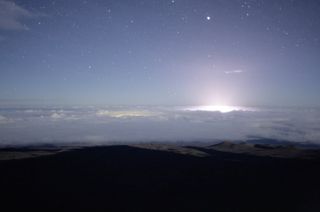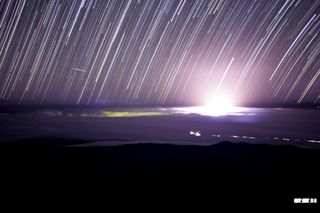Glow from Kilauea Volcano Outburst Captured in Stunning Observatory Video
A stunning new time-lapse video from the Gemini Observatory captures the dramatic glow of the Kilauea volcano eruption on Hawaii's Big Island.
The Kilauea outburst began on May 3, 2018, following an earthquake that struck the Big Island. Since then, the volcano has continued to spew lava, ash and toxic gas, destroying homes and causing people to evacuate.
The recent footage was taken during the night of May 21 to May 22, using the Gemini Observatory’s Gemini North telescope. The wide-angle camera at the Gemini North telescope sits high up on Mauna Kea, a tall volcanic peak on the Big Island, and is pointed in the direction of Kilauea. [In Photos: Hawaii's Kilauea Volcano Eruption as Seen from Space]

The time-lapse shows stars streaking across the night sky while clouds glow from the volcanic activity below. The glowing light comes from an extensive region of lava-spewing fissures generated by Kilauea's continued eruption, according to a statement from the Gemini Observatory.
The Gemini camera is looking eastward toward the town of Hilo, which is hidden by clouds. At the time the footage was taken, lava spread toward residential areas in the Puna District and began to flow into the ocean, creating so-called "laze" — a combination of lava and haze.

The time-lapse footage also captures the moon as it rises on the night of May 21 and illuminates the landscape. The infrared filter was removed from the camera, giving the volcanic glow its whitish-blue hue, rather than the expected red glow from the lava, according to the statement.
Generally, the Gemini North telescope is used to monitor atmospheric conditions. However, in this case, the footage captured from the telescope's unique vantage point above the cloud tops was used to create a specular time-lapse video of the intense volcanic activity wreaking havoc on the Big Island of Hawaii.
Get the Space.com Newsletter
Breaking space news, the latest updates on rocket launches, skywatching events and more!
You can see the latest updates on Kilauea's eruption here from our sister site Live Science.
Follow Samantha Mathewson @Sam_Ashley13. Follow us @Spacedotcom, Facebook and Google+. Original article on Space.com.
Join our Space Forums to keep talking space on the latest missions, night sky and more! And if you have a news tip, correction or comment, let us know at: community@space.com.

Samantha Mathewson joined Space.com as an intern in the summer of 2016. She received a B.A. in Journalism and Environmental Science at the University of New Haven, in Connecticut. Previously, her work has been published in Nature World News. When not writing or reading about science, Samantha enjoys traveling to new places and taking photos! You can follow her on Twitter @Sam_Ashley13.











